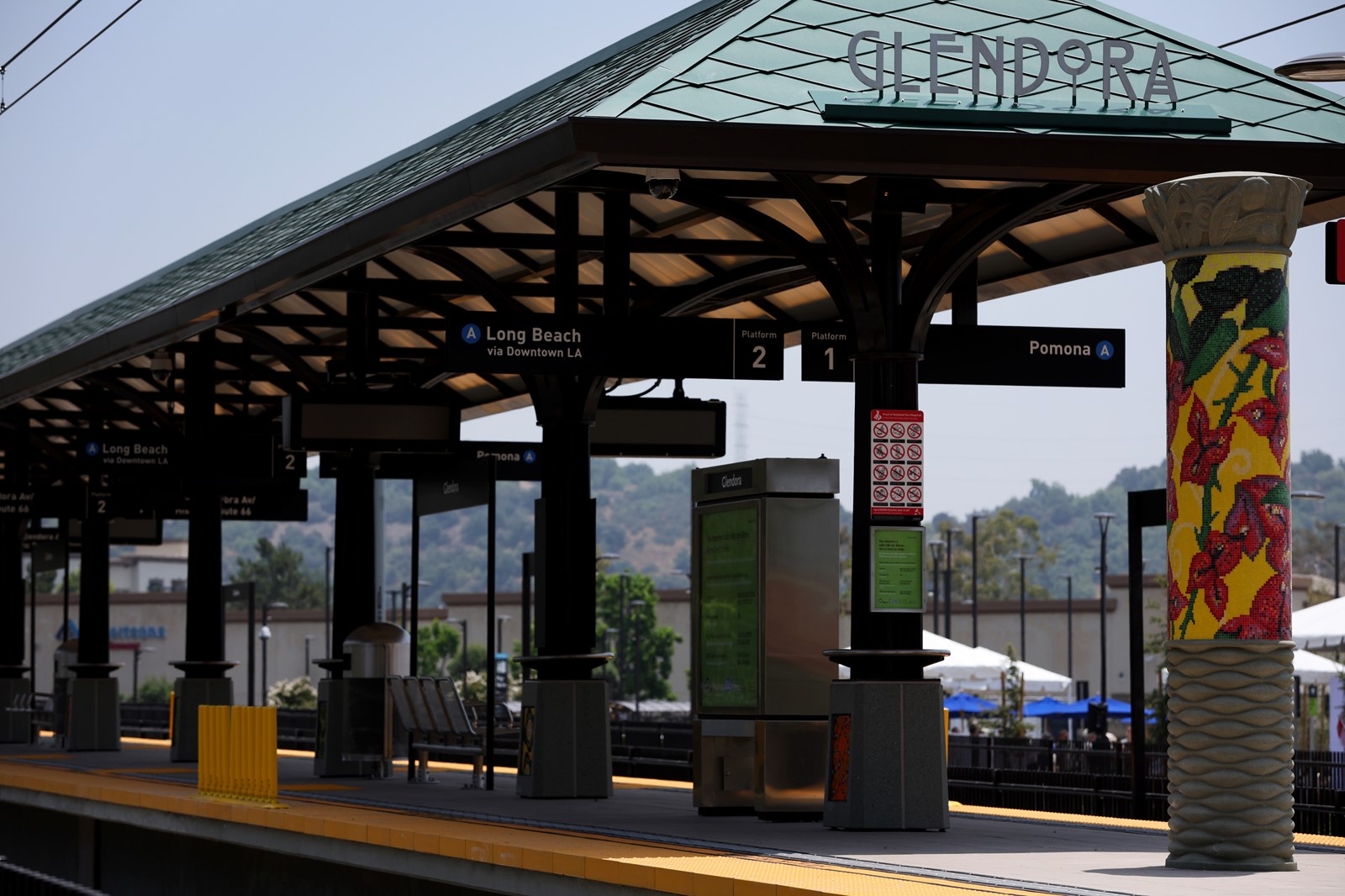
What has been missing from the city of Glendora for three-quarters of a century came back to this suburban town on Thursday.
That is, a train station where passengers can board an electric, light-rail train that soon will connect them with Pasadena, downtown Los Angeles, Long Beach and easterly to San Dimas, La Verne and Pomona. Of course, this new station soon will move folks the clean, zero-polluting way, using electric power — just like in the good ole days.
As members of the City Council, and the Foothill Gold Line Construction Authority board and others dedicated the new Glendora A Line Station under sunny skies, it marked the first time in 74 years Glendora will have a passenger train. The Pacific Electric Railway, known as the “Red Cars” moved people and sometimes crates of that citrus lifeblood from 1907 until 1951. The last Red Car pulled into the Glendora depot on Sept. 30, 1951.
“We look forward to a clean, safe and wonderful experience on the new rail service as we hail: ‘All Aboard!’” said Glendora Mayor David Fredendall in conclusion of his remarks.
The Glendora station is just one of four new stations to be dedicated on this 9.1-mile extension of the existing L.A. Metro A Line, formerly called the Gold Line, eventually adding service from Azusa to Pomona. The A Line, the longest light rail in the county, currently runs from Long Beach to Los Angeles, downtown L.A., Chinatown, Northwest L.A., Pasadena and City of Hope in Duarte with its eastern terminus in Azusa at Citrus College and Azusa Pacific University.
The next station dedication is for the San Dimas Station, on Saturday at 10 a.m.; the Pomona North Station dedication takes place on June 20 at 1:30 p.m.; the La Verne/Fairplex Station will be dedicated on June 21 at 10 a.m.
After more than five years of construction at a cost of $1.5 billion, the building of the 9.1-mile extension of the A Line from Azusa to Pomona was finished in January and handed over to L.A. Metro for testing. Trains have been making nighttime test runs since January and a new round of testing simulating actual time schedules will begin in a week or two, Metro reported.
The extension, which runs along the foothills of eastern Los Angeles County, will not open for passenger service until all testing is complete. This may last through August, meaning the extension could open to passengers then or earlier in the summer, said L.A. Metro, which operates the A Line.
Claremont City Councilmember Ed Reece, who chairs the Foothill Gold Line Construction Authority board, said the day was for reflecting on a build-out of the line that endured the pandemic, extreme heat and torrential rains. “Today we get to pause, reflect and celebrate a shared dream that began over a decade ago,” he said.
Former Glendora Mayor Doug Tessitor, instrumental in the early days of moving the project forward, is now living in Oregon and flew in to attend the dedication ceremony. But it didn’t take him long to experience the Southern California freeways on his ride from the airport.
“What I envision is the people who live in Glendora and have to work any place west of here, will be using this train very gratefully just to get from work and back. Because it is getting to be impossible on the freeways,” he said after the ceremony.
The new extension is partly a throwback to electric train rides of the past, but it also may represent a growing trend of using old rail rights-of-way for modern light-rail trains.
The return of a trolley, as they are sometimes known, spreading throughout Los Angeles County, is evident here in Glendora because the 9.1-mile extension of the Metro A Line from Azusa to Pomona used the right-of-way of another old train, the Los Angeles and San Gabriel Valley Railroad. The train line opened in 1887 and took passengers, at first, but was later swallowed up by the Santa Fe Railway as a freight line carrying crates of San Gabriel Valley grown lemons and oranges to markets across the United States.
The Santa Fe Railway even took oranges from Glendora to the White House, for President William Howard Taft to enjoy. The packing houses had freight spurs. The markets sold not just oranges and lemons but California sunshine, ironically spurring a real estate boom that brought in homes, roads, freeways and internal combustion engine vehicles, eliminating the passenger train service.
On the train platform are columns with mosaics depicting the town’s history, including bunches of lemons and oranges. Tiles also include depictions of fruit and flowers as well as a sunburst representing the town’s Craftsman homes, said artist Michael Hillman, describing his art work.
“It’s an homage to the area’s citrus industry,” which thrived in the early to middle 20th century.
One of his mosaics depicts a rare plant found growing in the Glendora hillsides, the thread-leafed Brodiaea, the only place in Los Angeles County where the endangered plant grows. “It was something very unique to Glendora,” he explained.


 PREVIOUS ARTICLE
PREVIOUS ARTICLE
